Peugeot 308 2017 Owner's Manual
Manufacturer: PEUGEOT, Model Year: 2017, Model line: 308, Model: Peugeot 308 2017Pages: 392, PDF Size: 10.16 MB
Page 241 of 392
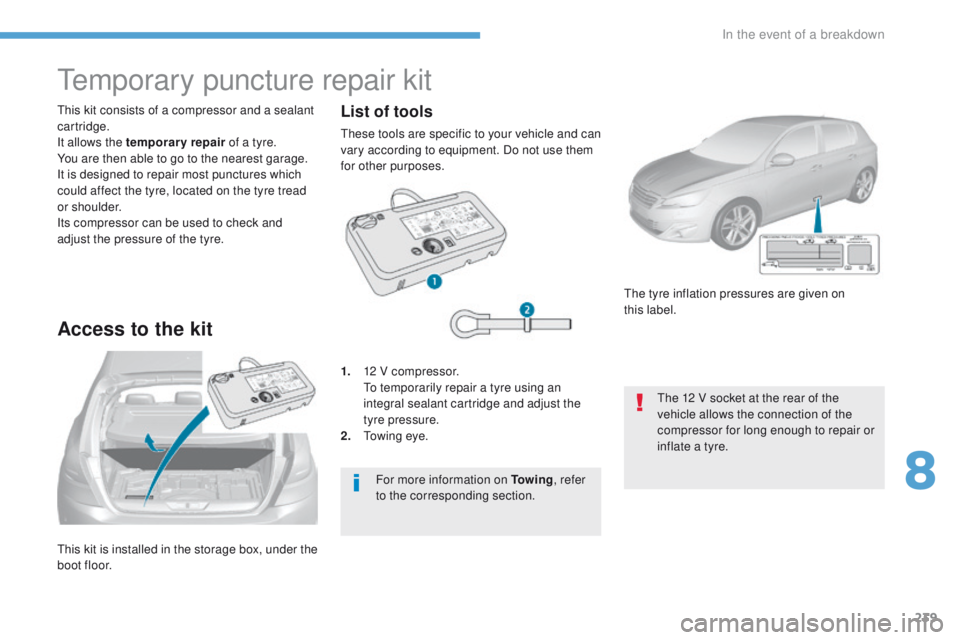
239
308_en_Chap08_en-cas-de-panne_ed01-2016
this kit is installed in the storage box, under the
boot floor.
th
is kit consists of a compressor and a sealant
cartridge.
It allows the temporary repair of a tyre.
You are then able to go to the nearest garage.
It is designed to repair most punctures which
could affect the tyre, located on the tyre tread
or shoulder.
Its compressor can be used to check and
adjust the pressure of the tyre.
temporary puncture repair kit
Access to the kit
1. 12 V compressor. to t emporarily repair a tyre using an
integral sealant cartridge and adjust the
tyre pressure.
2.
t
o
wing eye.
th
e tyre inflation pressures are given on
this
label.
th
e 12 V socket at the rear of the
vehicle allows the connection of the
compressor for long enough to repair or
inflate a tyre.
For more information on To w i n g , refer
to the corresponding section.
List of tools
these tools are specific to your vehicle and can
vary according to equipment. Do not use them
for other purposes.
8
In the event of a breakdown
Page 242 of 392
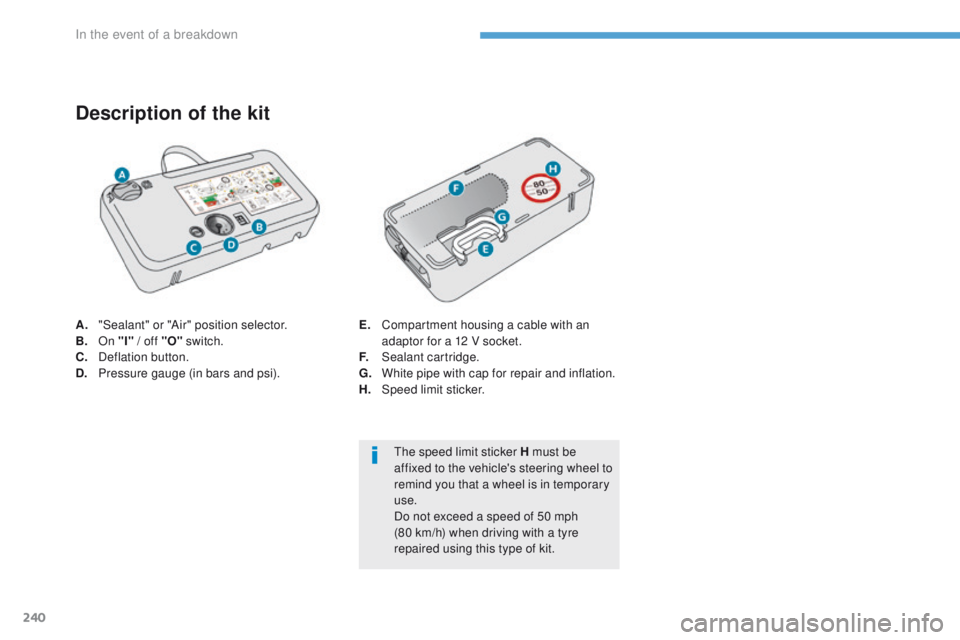
240
308_en_Chap08_en-cas-de-panne_ed01-2016
A. "Sealant" or "Air" position selector.
B.
On "I" / off "O" switch.
C.
D
eflation button.
D.
P
ressure gauge (in bars and psi).
Description of the kit
E. Compartment housing a cable with an adaptor for a 12 V socket.
F.
S
ealant cartridge.
G.
W
hite pipe with cap for repair and inflation.
H.
Spe
ed limit sticker.
th
e speed limit sticker H must be
affixed to the vehicle's steering wheel to
remind you that a wheel is in temporary
use.
Do not exceed a speed of 50 mph
(80 km/h) when driving with a tyre
repaired using this type of kit.
In the event of a breakdown
Page 243 of 392
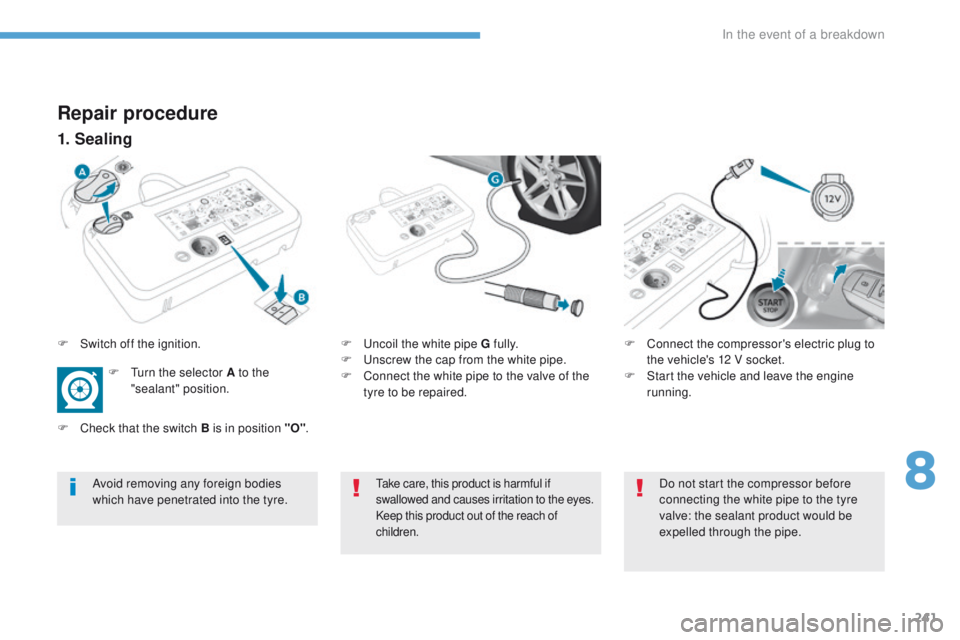
241
308_en_Chap08_en-cas-de-panne_ed01-2016
Repair procedure
1. Sealing
F uncoil the white pipe G fully.
F
un screw the cap from the white pipe.
F
C
onnect the white pipe to the valve of the
tyre to be repaired. F
C onnect the compressor's electric plug to
the vehicle's 12 V socket.
F
S
tart the vehicle and leave the engine
running.
take care, this product is harmful if
swallowed and causes irritation to the eyes.
Keep this product out of the reach of
children.Avoid removing any foreign bodies
which have penetrated into the tyre. Do not start the compressor before
connecting the white pipe to the tyre
valve: the sealant product would be
expelled through the pipe.
F
S
witch off the ignition.
F t
u
rn the selector A to the
"sealant" position.
F
C
heck that the switch B is in position "O"
.
8
In the event of a breakdown
Page 244 of 392
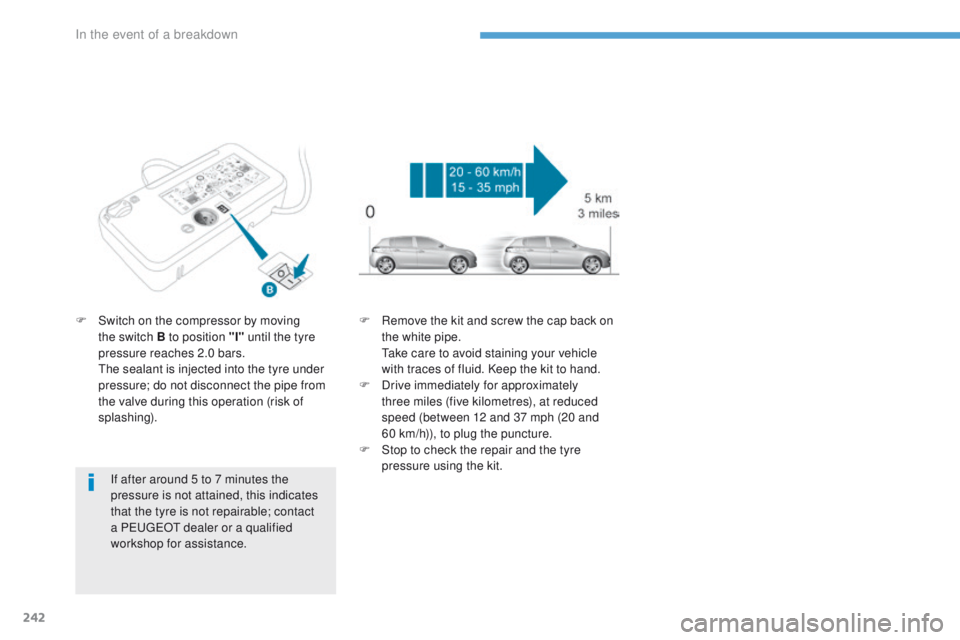
242
308_en_Chap08_en-cas-de-panne_ed01-2016
If after around 5 to 7 minutes the
pressure is not attained, this indicates
that the tyre is not repairable; contact
a P
e
uge
Ot
dealer or a qualified
workshop for assistance.
F
S
witch on the compressor by moving
the switch B to position "I" until the tyre
pressure reaches 2.0 bars.
t
h
e sealant is injected into the tyre under
pressure; do not disconnect the pipe from
the valve during this operation (risk of
splashing). F
R
emove the kit and screw the cap back on
the white pipe.
t
a
ke care to avoid staining your vehicle
with traces of fluid. Keep the kit to hand.
F
D
rive immediately for approximately
three miles (five kilometres), at reduced
speed (between 12 and 37 mph (20 and
60 km/h)), to plug the puncture.
F
S
top to check the repair and the tyre
pressure using the kit.
In the event of a breakdown
Page 245 of 392

243
308_en_Chap08_en-cas-de-panne_ed01-2016
F Connect the compressor's electric plug to
the vehicle's 12 V socket.
F
S
tart the vehicle again and leave the
engine running. F
A djust the pressure using the compressor
(to inflate: switch B in position "I" ; to
deflate: switch B in position "O" and press
button C ), in accordance with the vehicle's
tyre pressure label (located on the left-
hand door aperture).
A l
oss of pressure indicates that the
puncture has not been fully plugged;
contact a P
e
uge
Ot
dealer or qualified
workshop for assistance.
F
R
emove and stow the kit.
F
D
rive at reduced speed (50 mph [80 km/h]
max) limiting the distance travelled to
approximately 120 miles (200 km).
As soon as possible, go to a P
e
uge
Ot
dealer or a qualified workshop.
You must inform the technician that you
have used this kit. After inspection, the
technician will advise you on whether
the tyre can be repaired or if it must be
replaced.
2. Inflation
F turn the selector A to the "Air" position.
F
u
n
coil the white pipe G fully.
F
C
onnect the white pipe to the tyre valve.
8
In the event of a breakdown
Page 246 of 392
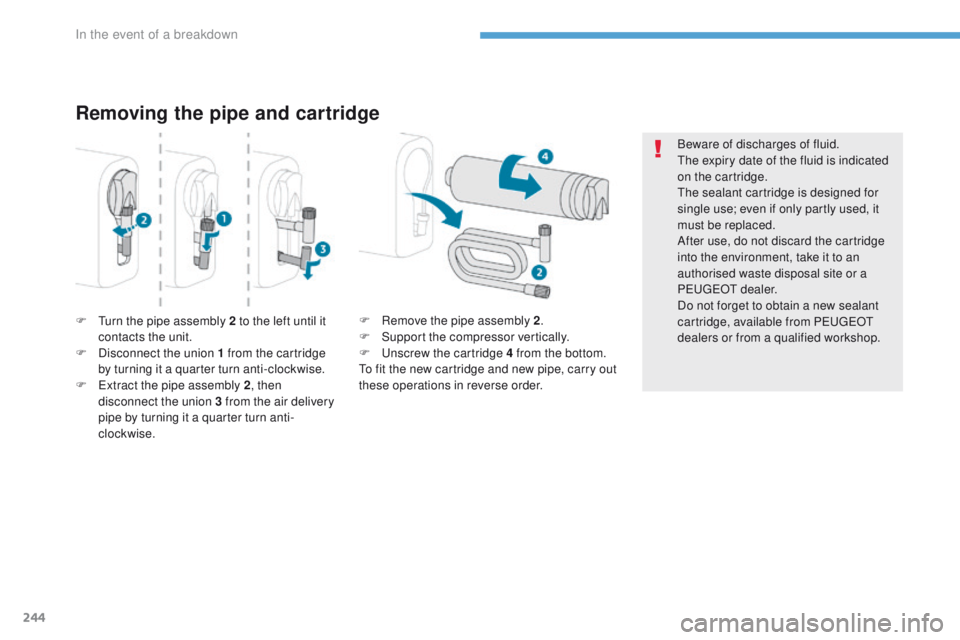
244
308_en_Chap08_en-cas-de-panne_ed01-2016
Removing the pipe and cartridge
F turn the pipe assembly 2 to the left until it
contacts the unit.
F
D
isconnect the union 1 from the cartridge
by turning it a quarter turn anti-clockwise.
F
e
x
tract the pipe assembly 2 , then
disconnect the union 3 from the air delivery
pipe by turning it a quarter turn anti-
clockwise. Beware of discharges of fluid.
th
e expiry date of the fluid is indicated
on the cartridge.
th
e sealant cartridge is designed for
single use; even if only partly used, it
must be replaced.
After use, do not discard the cartridge
into the environment, take it to an
authorised waste disposal site or a
P
e
uge
Ot d
ealer.
Do not forget to obtain a new sealant
cartridge, available from Pe ugeOt
dealers or from a qualified workshop.
F
R emove the pipe assembly 2
.
F S upport the compressor vertically.
F
u
n
screw the cartridge 4 from the bottom.
to f
it the new cartridge and new pipe, carry out
these operations in reverse order.
In the event of a breakdown
Page 247 of 392
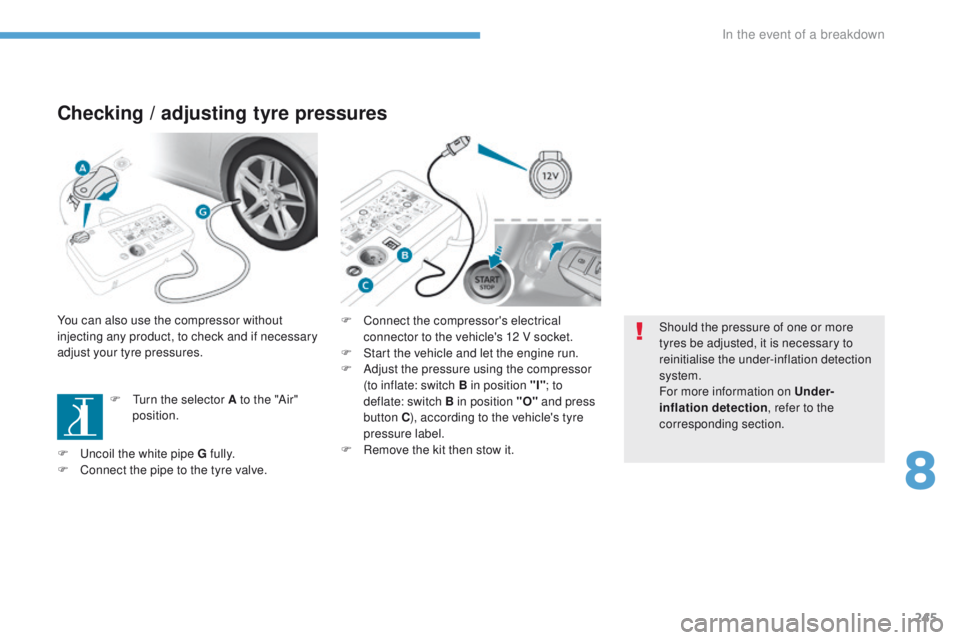
245
308_en_Chap08_en-cas-de-panne_ed01-2016
Checking / adjusting tyre pressures
You can also use the compressor without
injecting any product, to check and if necessary
adjust your tyre pressures.
F
t
u
rn the selector A to the "Air"
position. F
C onnect the compressor's electrical
connector to the vehicle's 12 V socket.
F
S
tart the vehicle and let the engine run.
F
A
djust the pressure using the compressor
(to inflate: switch B in position "I" ; to
deflate: switch B in position "O" and press
button C ), according to the vehicle's tyre
pressure label.
F
R
emove the kit then stow it.Should the pressure of one or more
tyres be adjusted, it is necessary to
reinitialise the under-inflation detection
system.
For more information on Under-
inflation detection
, refer to the
corresponding section.
F
u
n
coil the white pipe G fully.
F
C
onnect the pipe to the tyre valve.
8
In the event of a breakdown
Page 248 of 392
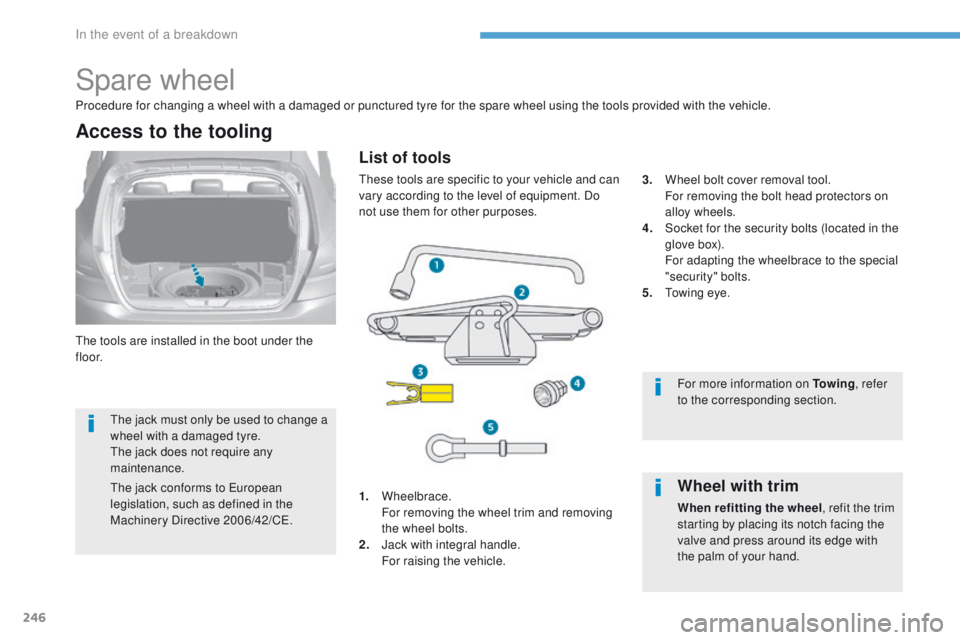
246
308_en_Chap08_en-cas-de-panne_ed01-2016
Spare wheel
the tools are installed in the boot under the
f l o o r.
Access to the tooling
1. Wheelbrace. F
or removing the wheel trim and removing
the wheel bolts.
2.
J
ack with integral handle.
F
or raising the vehicle. 3.
W
heel bolt cover removal tool.
F
or removing the bolt head protectors on
alloy wheels.
4.
S
ocket for the security bolts (located in the
glove box).
F
or adapting the wheelbrace to the special
"security" bolts.
5.
t
o
wing eye.
Procedure for changing a wheel with a damaged or punctured tyre for the spare wheel using the tools provided with the vehicle.
For more information on To w i n g, refer
to the corresponding section.Wheel with trim
When refitting the wheel , refit the trim
starting by placing its notch facing the
valve and press around its edge with
the palm of your hand.
List of tools
these tools are specific to your vehicle and can
vary according to the level of equipment. Do
not use them for other purposes.
th
e jack must only be used to change a
wheel with a damaged tyre.
th
e jack does not require any
maintenance.
th
e jack conforms to
e
u
ropean
legislation, such as defined in the
Machinery Directive 2006/42/C
e.
In the event of a breakdown
Page 249 of 392
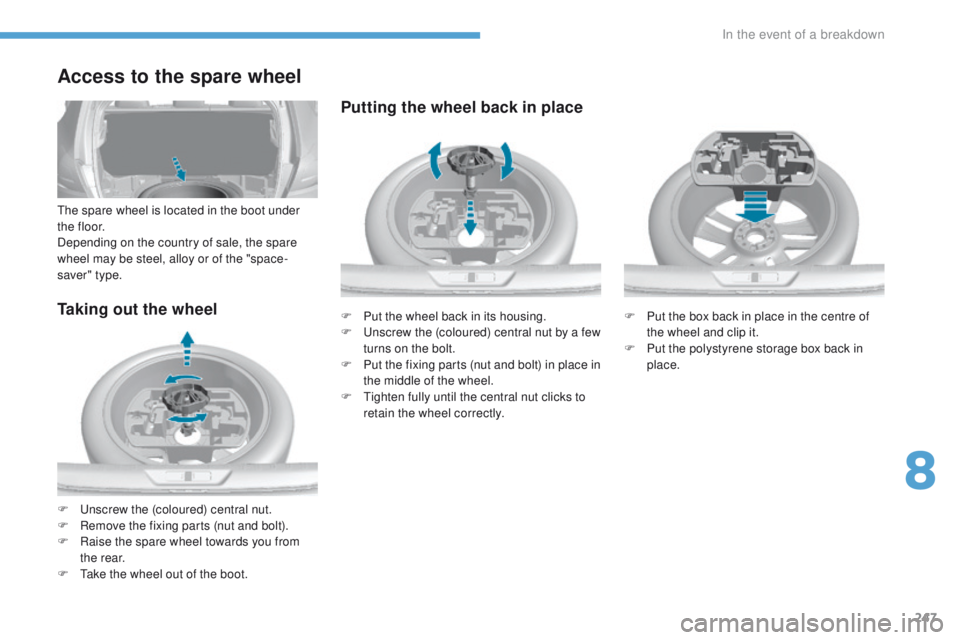
247
308_en_Chap08_en-cas-de-panne_ed01-2016
Taking out the wheel
F unscrew the (coloured) central nut.
F
R emove the fixing parts (nut and bolt).
F
R
aise the spare wheel towards you from
the rear.
F
t
a
ke the wheel out of the boot.
Access to the spare wheel
the spare wheel is located in the boot under
t h e f l o o r.
Depending on the country of sale, the spare
wheel may be steel, alloy or of the "space-
saver" type.
Putting the wheel back in place
F Put the box back in place in the centre of the wheel and clip it.
F
P
ut the polystyrene storage box back in
place.
F
P
ut the wheel back in its housing.
F
un
screw the (coloured) central nut by a few
turns on the bolt.
F
P
ut the fixing parts (nut and bolt) in place in
the middle of the wheel.
F
t
i
ghten fully until the central nut clicks to
retain the wheel correctly.
8
In the event of a breakdown
Page 250 of 392
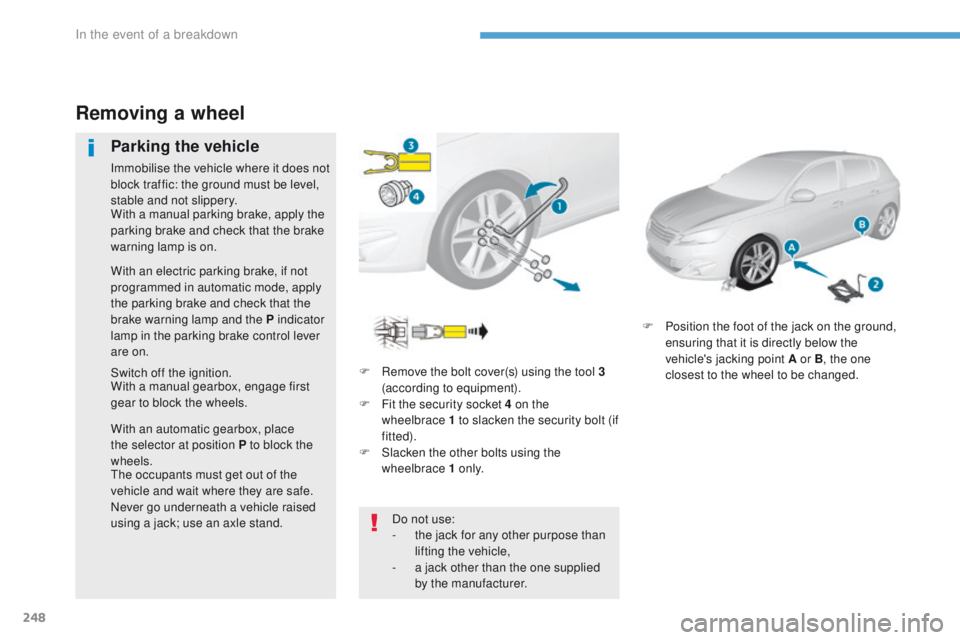
248
308_en_Chap08_en-cas-de-panne_ed01-2016
F Remove the bolt cover(s) using the tool 3
(according to equipment).
F
F
it the security socket 4 on the
wheelbrace
1 to slacken the security bolt (if
fitted).
F
S
lacken the other bolts using the
wheelbrace 1 o n l y. F
P
osition the foot of the jack on the ground,
ensuring that it is directly below the
vehicle's jacking point A or B , the one
closest to the wheel to be changed.
Removing a wheel
Parking the vehicle
Immobilise the vehicle where it does not
block traffic: the ground must be level,
stable and not slippery.
Switch off the ignition. With a manual parking brake, apply the
parking brake and check that the brake
warning lamp is on.
With an electric parking brake, if not
programmed in automatic mode, apply
the parking brake and check that the
brake warning lamp and the P indicator
lamp in the parking brake control lever
are on.
With a manual gearbox, engage first
gear to block the wheels.
With an automatic gearbox, place
the selector at position P to block the
wheels.
th
e occupants must get out of the
vehicle and wait where they are safe.
Never go underneath a vehicle raised
using a jack; use an axle stand. Do not use:
-
t
he jack for any other purpose than
lifting the vehicle,
-
a j
ack other than the one supplied
by the manufacturer.
In the event of a breakdown